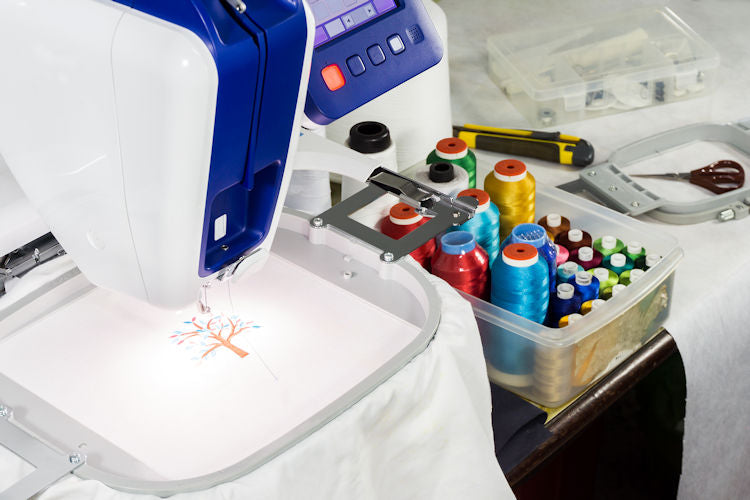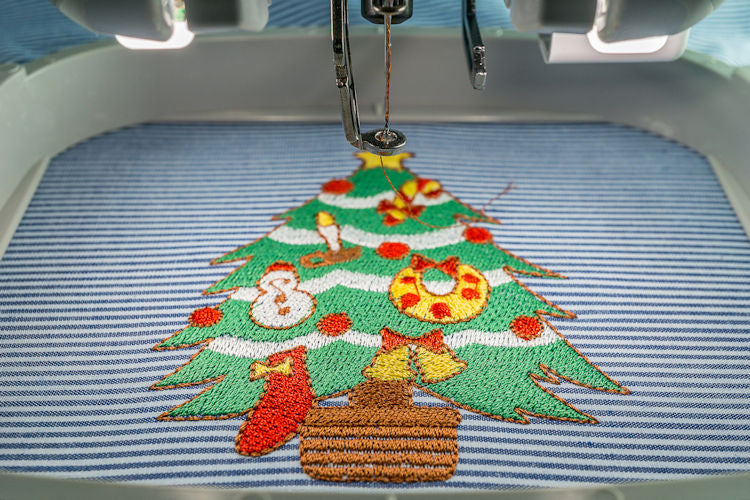Get help
Browse our collection of educational articles.

Did you just buy a new embroidery machine and are excited to get started embroidering some clothes but have no idea how? Being a beginner in the machine embroidery industry has it's challenges but we are here to help.
Working with a machine to embroider designs can seem daunting at first, but don't worry – mastering the craft is easier than you might think! We've compiled some smart advice and helpful guidance on becoming an expert in this popular pastime. So take your time, study up, and get ready for hours of stitching success!
The first thing you need after you buy your machine, is some good quality supplies. The basics you going to want to buy are thread, bobbins, backing (also called stabilizer), needles, and some good quality scissors. Those basics should get you started. For help on what to purchase, please consult some of our other blogs for more detailed information.
Our most important advice for purchasing new embroidery supplies, is to make sure you are buying quality products designed for machine embroidery. Make sure they are compatible with your machine and from a reputable source, like AllStitch Embroidery Supplies.
Most embroidery supplies on the market will work with both home and commercial machines; but there are a few specialized items, like needles and bobbins, that are machine specific. If you are not sure what to buy, consult your manual, ask your dealer or other embroiderers.
The user manual that comes with your embroidery machine is full of helpful information about how to use your machine properly and effectively. It will go over things like threading the machine, changing needles or bobbins, using stabilizers or backings appropriately, and more.
Your machine manual will explain the different types of stitches and embroidery patterns that your machine can create, and how to access them. This information will help you to choose the right stitch for your project, and ensure that your designs come out looking professional.
There will be times when things go wrong with your embroidery machine. Your manual will provide you with helpful troubleshooting tips and guidelines for fixing common problems, so you can get back to doing what matters. Every so often there will be an issue that will be better resolved with an embroidery Facebook group, but I'll address that later on
Many new embroiders never learn how to hoop correctly and end up floating everything they embroider. Floating means only hooping the embroidery backing and then attaching what you want to embroider to the hooped backing with adhesive or a basting stitch.

This works fine for bulky items that are too difficult to hoop; but for most of what you will embroider, hooping the garment will provide more stability and produce a much better finished product. Make sure you choose the right hoop for the job. The best stability will be achieved with he smallest hoop the design will fit into. After you have the size hoop needed, you are ready to grab your backing.
In order to be able to hoop easily, make sure the stabilizer you are using is large enough to fit your hoop. Before buying precut sheets, measure the outside dimensions of your hoop and purchase a size that is at least 1" larger than your hoop in both directions.
The general rule for hooping is: you want your fabric taut like a tambourine skin, but you do not want to stretch it. Stretching the fabric when you hoop it will cause distortion and puckering after you remove your embroidery from the hoop.
Digitizing is the process of converting a design into a digital set of instructions that your embroidery machine can understand. Digitizing is an entirely separate skill set that takes time to perfect. When starting out with machine embroidery, you should concentrate on learning to operate your machine and leave the digitizing to the experts.
Poorly digitized designs will stitch poorly. There are plenty of sites on the internet that sell digitized embroidery designs and digitizers that will convert your custom design or logo for you. Make sure you are buying from a reputable site. Ask fellow embroiderers for referrals and avoid sites selling designs that violate copyright and trademark laws.
Here is some valuable advice when you are beginning machine embroidery - practice a lot. I can't tell you how many calls we get from people that bought a new embroidery machine and are starting their first job after taking it out of the box. Build a test stash of all types of clothing, towels and linens to test on.
Experiment with different types of backing on different fabrics until you are comfortable with what combinations produce the best designs. Learn what a good stitch should look like and recognize when your machine is not stitching properly. Start with simple projects and work your way up to the more complex ones. Read lots of tips, watch tutorials, and become a sponge. Practicing on test items will ease your anxiety and when you have no fear of making mistakes, you will learn faster.

We were all embroidery beginners at one time, none of us were born knowing how to operate an embroidery machine. Embroiderers are great bunch of people who are always willing to help.
Join a support group like the Machine Embroidery Help Group on Meta where you will find over 50,000 embroiderers eager to help with your new embroidery machine.
In this group you can learn from others, collaborate, and ask specific embroidery questions. There are topics covered such as embroidery tips, doing applique, choosing stabilizers, tension settings, and more.
To get the best help in the group, make sure you ask detailed questions and add a picture of what you are trying to do or the issue you are having.
We recently made another longer, more informative page about all of the things you should know when beginning embroidery. We hope that you are able to find that helpful.
Comments
Leave a comment